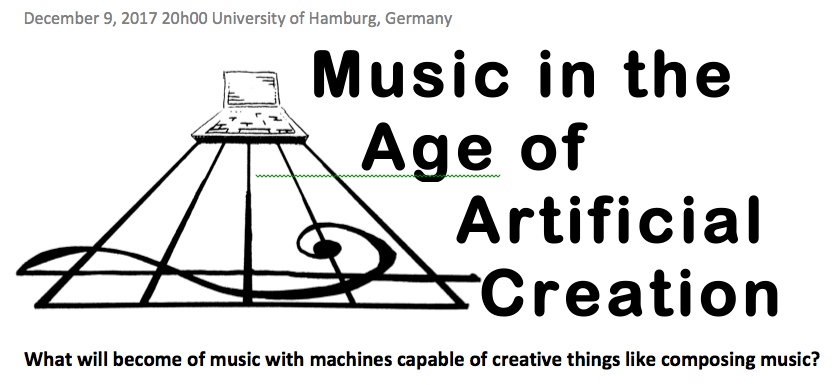
What will become of music with machines capable of creative things like composing music?
The pieces in this concert come from our application of machine learning to model a crowd-sourced collection of over 23,000 music transcriptions available online at https://thesession.org. This collection consists of many transcriptions of traditional music played in Ireland and the UK. Here is one example transcription with symbols specifying the meter, key and basic melody of the tune, “The Morning Lark”:
M: 6/8 K: Dmaj AFD D2A,|DEF Adc|BGG DGG|B2B BdB|AFD D2A,|DEF A3|def gfe|fd^c d2B:| |:ABd fdd|add fdB|Add fed|edB BAF|Add fdd|add fdd|faf ede|fd^c d2B:|
Our machine learning system (folk-rnn) creates models of these transcriptions, which one can then use to generate any number of new transcriptions that resemble those in the real collection. Here’s one example transcription completely “composed” by our models:
M:6/8 K:Dmix |:A2D D2B|AGE c2A|GEE c2E|E2D DEG|A2D D2B|AGE c2d|ecA GEA|D3 D3:| |:Add Add|ede dcA|GEE cEE|GAB cBc|Add Add|edc AGA|BcB AGE|D3 D3:|
We are interested in how such machine learning models can contribute to music practice, both in and out of the traditional practices of the training data. We are also interested in how the methods used to create such models can themselves be improved by working together with practitioners.
The works on this concert demonstrate different ways of making music with our models. Sturm builds his three short works through curation from a large number of tunes generated by the model. In fact, the example transcription above is the subject of his “March to the Mainframe”. Another work, “The Humours of Time Pigeon”, comes from a failure of the model, which is nonetheless the right kind of failure. To create material for his piece “Bastard Tunes”, Ben-Tal interacts with the model by seeding its transcription generation process using melodic fragments that are different from the patterns in its training data – “prodding” it out of its “Irish training”. Each movement of “Bastard Tunes” is built using the continuations generated by the model.
Technological innovation has transformed music in the past, from the development of the piano to the gramophone to online streaming services. Machines of all kinds play a significant role in our musical life from the recording studio to the devices through which we listen to the music. What will be the impact of today’s technologies on music, musicians, and audiences? While there is much concern about artificial intelligence replacing or even displacing humans, this concert shows the potential for these approaches to augment human creativity. Music machine learning opens new avenues for engaging with music, and developing new practices.